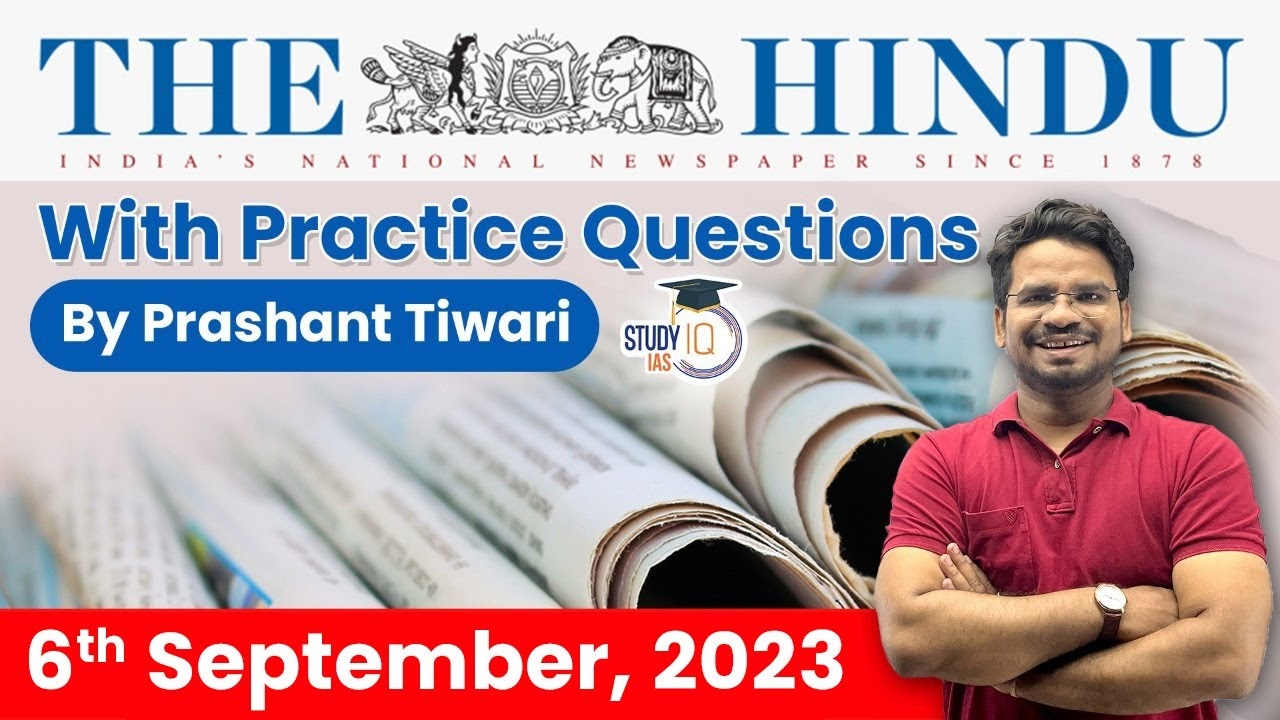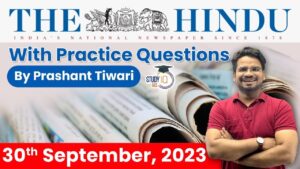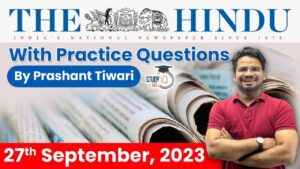The Hindu Newspaper Analysis for UPSC

The Hindu Newspaper Analysis 5 September 2023
- Invitations sent by President Droupadi Murmu to the heads of states and governments and the Chief Ministers of Indian States for an official banquet on the occasion of the G-20 Summit in New Delhi created a flutter as the word “India” was replaced with “Bharat”.
- Instead of the usual “President of India”, the invitation cards said “President of Bharat”.
The Hindu Editorial Today
What is Article 1?
- Article 1 says “India, that is Bharat, shall be a Union of States.” This particular article of the Constitution is a crucial statement as it lays down what our nation will be called.

- Jammu and Kashmir has not held legislative elections for the past nine years. The last Assembly election was in 2014, and the last elected administration fell in June 2018. After almost a year of President’s Rule, the Jammu and Kashmir Reorganisation Act, 2019 divided the State into two Union Territories.
- Like the National Capital Territory of Delhi, Jammu and Kashmir is entitled to an elected Assembly with curtailed powers (for example, law and order remained with the Union Home Ministry and security with the Lieutenant-Governor); Ladakh is not.
- Holding an Assembly election before the year-end can build confidence, as prior experience shows. The Atal Bihari Vajpayee administration held elections in 2002, at a time when insurgency had taken a heavy toll. But that election ushered in 12 years of peace-building, with two free and fair elections.

- On August 24, the 15th BRICS summit in Johannesburg announced that the five-member grouping (Brazil, Russia, India, China and South Africa) had invited six new members — Iran, Saudi Arabia and the United Arab Emirates (UAE) from West Asia; Egypt and Ethiopia from Africa, and Argentina from Latin America.
- It was reported that 40 countries have shown interest in BRICS’ membership, with 22 having submitted formal applications.
- From 2009, BRICS has met annually at summit level, and is backed by several ministerial and expert conclaves.
- It has spawned two major institutions – the New Development Bank (NBD) to provide development assistance and the Contingent Reserve Arrangement that supports countries facing short-term balance-of-payments pressures. The NBD has already financed 96 projects valued at $33 billion.
- BRICS members have been united in their dissatisfaction with the West-dominated international institutions that had emerged after the Second World War — the World Bank, the International Monetary Fund, the United Nations and its various bodies, particularly the Security Council, and more recently, the World Trade Organization.
- The new BRICS members will bring considerable geo-strategic value to the grouping. Those from West Asia are already closely tied to BRICS members: 35% of Saudi oil production goes to China and India; Russia, already a major oil supplier to China and India, is now looking at Brazil as a market. Despite sanctions by the United States, Iran has increased oil production from a low of 400,000 barrels per day in the Trump period to 2.2 mbd in August this year, most of it going to China.
- Egypt and Ethiopia are an important presence in the strategically important Horn of Africa and the Red Sea, while Argentina is the second largest economy in Latin America.

- The destruction wreaked by the floods in north India in August has evoked concern at the highest levels. Last month, a Bench headed by Chief Justice of India D.Y. Chandrachud had suggested that an expert committee conduct a “complete and comprehensive” study on the carrying capacity of the Himalayan region.
- Following this, the Centre has proposed setting up a 13-member technical committee.
- “Carrying capacity” is a concept derived from population-biology and generally refers to the quantity of a species that can thrive sustainably in a defined ecosystem.
- The crisis of land subsidence experienced in Joshimath, Uttarakhand, in January had also sparked a debate on the conflict between infrastructural development and ecology, but in a matter of months, Himachal Pradesh saw an unexpected deluge washing away roads and highways built on denuding mountains.

- With Chinese President Xi Jinping skipping a G-20 Summit for the first time, Beijing is sending “deliberate signals” to India and the West by essentially downgrading its involvement in a key international forum, according to current and former officials and people familiar with Beijing’s thinking.
- Missing the summit, they said, conveys China’s displeasure both with the current state of bilateral ties with India — and New Delhi’s stand that normalcy in broader ties is not possible without a restoration of peace on the Line of Actual Control (LAC) — and with what Beijing sees as a “politicisation” of the G-20, which it believes should be limited to economic issues and not involve itself with issues such as the war in Ukraine.

- Southeast Asian leaders decided that Myanmar won’t take over the rotating leadership of their regional bloc as scheduled in 2026, Asian diplomats and a leader said on Tuesday, in the latest blow to efforts by its ruling Generals to gain international recognition after violently seizing power in 2021.
- Western governments led by the U.S. have condemned the Myanmar Army’s ouster of Aung San Suu Kyi’s democratically elected government in 2021 and have demanded her immediate release from years-long detention along with other officials.
- The Philippines agreed to take over the regional bloc’s chairmanship in 2026 at an ASEAN summit hosted by Indonesia on Tuesday, Philippine President Ferdinand Marcos Jr. said in a statement, citing what he told fellow leaders in the closed-door meetings.

What is ASEAN?
- The Association of Southeast Asian Nations (ASEAN) is a regional grouping that aims to promote economic and security cooperation among its ten members: Brunei, Cambodia, Indonesia, Laos, Malaysia, Myanmar, the Philippines, Singapore, Thailand, and Vietnam.
- Establishment: It was established on 8 August 1967 in Bangkok, Thailand, with the signing of the ASEAN Declaration (Bangkok Declaration) by the founding fathers of ASEAN: Indonesia, Malaysia, Philippines, Singapore and Thailand.
- Aim: The motto of ASEAN is “One Vision, One Identity, One Community”.
- Secretariat: ASEAN Secretariat is located in Jakarta, Indonesia.
- ASEAN countries have a total population of 662 million people and a combined gross domestic product (GDP) of $3.2 trillion as of 2022.

- Russia, which is strong in vaccine R&D and weak in production and distribution, has relied on outsourcing vaccine production with technology transfer.
- So, this was the approach Russia took with its Sputnik-V vaccine. Riding the rich experience of the Soviet era, it was the first to develop a vaccine for COVID-19. But with severely limited production capacity, Russia contracted out Sputnik-V production to pharmaceutical manufacturers in Asia, Latin America and Eastern Europe.
- As for India, the paper notes that the country was producing 60% of the world’s vaccines even before the pandemic. So India’s vaccine diplomacy was “characterised by mass-production of Western-invented vaccines, prompt bilateral donations, and large-scale sales to bilateral buyers and multilateral COVAX initiative.” The “Western-invented” Covishield was the major currency of India’s vaccine diplomacy, as it leveraged the massive capacity of SII, the world’s largest vaccine producer.
- India quickly rolled out large scale bilateral programs called ‘Vacciner Maitri’ (Vaccine Friendship). With more than 90 countries swiftly approaching India, neighbouring countries got priority access to India’s donations, the paper states.
- Coming to China, the paper points out that “China’s vaccine diplomacy is the costliest, with tremendous investments in vaccine development, production, and distribution”. Though it arranged its clinical trials, sales and donations across the developing world, it provided preferential access only to African and ASEAN countries — regions that are focus areas of the Belt and Road Initiative (BRI). While its vaccine aid has been mostly bilateral, the geopolitical rivalry between China and India in South Asia meant that Pakistan became “the first and largest beneficiary of China’s vaccine aid”.
- For instance, when Russia received a large order from Brazil, it outsourced production to China and India. China, on its part, had conducted clinical trials in Brazil, and Russia, while it also supplied API (active pharmaceutical ingredients) to Brazil, it had done the same for India for Covishield production. And India has exported Covishield to Brazil and South Africa.


 The Hindu Newspaper Analysis 6 October 2...
The Hindu Newspaper Analysis 6 October 2...
 The Hindu Newspaper Analysis 30 Septembe...
The Hindu Newspaper Analysis 30 Septembe...
 The Hindu Newspaper Analysis 27 Septembe...
The Hindu Newspaper Analysis 27 Septembe...





















